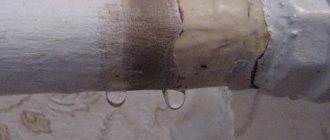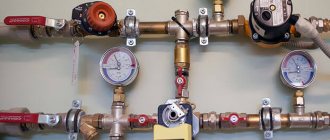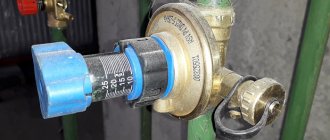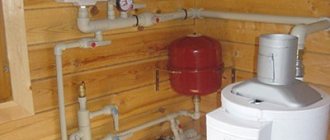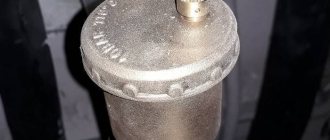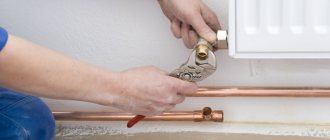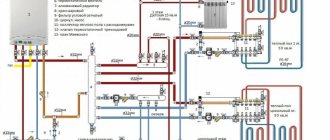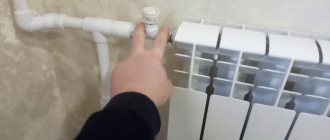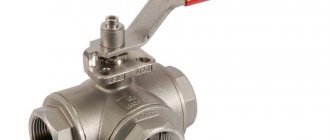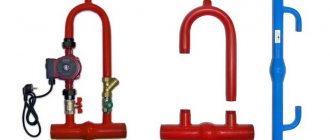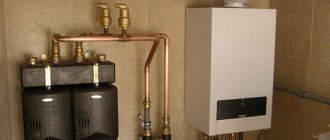For heating networks in private houses and apartments, it is advisable to use boilers with closed coolant circulation, i.e. double-circuit. This design allows you to increase the pressure of the working fluid in the circuit.
High pressure in the heating system ensures safety and a higher boiling point of the coolant, therefore, the economic effect of the installation increases, and a decrease in pressure leads to problems in the system. Therefore, let’s look at why the pressure in the heating system of a double-circuit boiler drops and how to raise it.
The parameters of the boiler unit are monitored by measuring instruments - pressure gauges, main and additional. If a pressure gauge should be included in instrumentation and control measures, then choose models with electronic sensors.
Factors that affect the pressure inside the circuit:
- The impact of the coolant on the walls of the heating network elements;
- Height of laying pipes, hanging radiators and boiler unit;
- Design of main pipeline sections.
The pressure value for autonomous heating is not standardized. Acceptable values of network parameters are calculated based on the data of a specific object:
- Boiler type, pipe characteristics (diameter, presence of reinforcement, etc.), type and number of radiators;
- Equipment installation location, circuit length;
- Number of floors of the house;
- Parameters and condition of the external water pipeline.
It is important to know! The pressure in the system is determined by the lowest value (usually at the most distant point). In forward and return, the pressure difference should be up to 0.3...0.5 atm to ensure normal circulation of the working fluid.
Connecting a single-circuit and double-circuit boiler
Causes of pressure drop in the circuit:
- Presence of leaks in the pipeline;
- Malfunction of the boiler, cracks on the surface of the heat exchanger;
- Malfunction of the membrane valve responsible for the safety of boiler equipment;
- Failure of the expansion tank membrane;
- Depressurization of the hot water supply circuit.
Why do you have to add water to the system?
For the boiler to work correctly, it is necessary to maintain the recommended pressure in the system. Obviously, for this to happen, a constant volume of coolant must circulate in the water heating system. And it can change during operation even in a perfectly designed and assembled structure. Loss of coolant occurs when:
- The air is bleed through the Mayevsky valve located on the radiator. As you know, you have to open the air vent and wait until a trickle of water comes out of it.
- In automatic mode, excess pressure is released through a safety valve due to a change in the operating mode of the system. In this case, the coolant escapes into the atmosphere in a gaseous state.
- The filters are cleaned from mechanical contaminants.
- There are significant or microscopic leaks, for example through dismountable connections.
- In systems with natural circulation, water evaporates through an open expansion tank.
Nuances of pressure drop in boilers from different manufacturers
Ariston
This manufacturer has a bypass element that allows you to solve the problem of how to increase the pressure in the Ariston boiler during a power outage.
It allows you to reduce excessive heating of the heat exchanger due to insufficient water flow. The flow of coolant in the system starts, bypassing the circulation pump.
Baxi
The minimum pressure for these boilers is half a bar; if it is insufficient, errors E40 and E41 are displayed on the boiler screen. It can be adjusted with a tire pump, since the valve on Baksi boilers is a regular car nipple.
Note! When the coolant is first introduced into the system, the boiler may display error E10, but it goes away automatically.
Navien
These Korean boilers are designed for a pressure drop of up to 0.1 bar, which minimizes emergency blockages. Such units are ideal for high-rise buildings. The boiler is equipped with a system of nozzles, protective systems and supply devices that allow it to operate at a pressure reduced to 4 mbar. You can regulate the pressure using a remote control.
How recharge works
The main task of the make-up unit is to add the missing coolant to the heating system until the operating pressure returns to normal. In most cases, heating make-up is connected to a cold water supply, but the system can also be powered from a storage tank. There are two ways to replenish the coolant volume.
- Manual mode. It is usually used in small systems. The user himself periodically monitors the pressure using the pressure gauge and, when necessary, opens the appropriate taps. Water flows by gravity, or a make-up pump is used for heating. In the simplest gravity installations, water is collected until it comes out of an overflow pipe welded to the expansion tank.
- Automatic recharge of the heating system. If the pressure in the system drops below the set value, the heating system feed valve (or electric valve/valve) is activated, which opens the flow hole. If necessary, voltage is applied in parallel to the sediment, and water will begin to forcefully enter the system. When the pressure readings return to normal, the valve will close and the pumping equipment will turn off. Sometimes the power supply is part of the heat generator. The advantage of using automation is that there is no need to engage in control; everything happens without the participation of the homeowner. The disadvantage is the fact that another element appears in the circuit that needs power supply.
Note that this unit is used not only for adding water during operation. Through it the following is carried out:
- initial filling of coolant into the system;
- complete discharge of water (for example, for repairs);
- water preparation (coarse filtration, softening);
- flushing the system;
- crimping.
Ways to increase pressure in the boiler
This problem is solved in different ways depending on what caused its fall.
In case of leaks detected visually or by a thermal imager, the problem is eliminated by tightening or sealing the connection or completely replacing the unit.
Note! Before pumping up pressure in case of ruptures in the boiler expansion tank or etching of the nipple, this element must be replaced with a new one. In difficult situations, the tank itself has to be replaced.
Cracks in the heat exchange elements of the boiler are visualized by long-term observation or with the help of specialists, after which it is necessary to seal the damaged section of the circuit.
To eliminate air pockets in the system, it is necessary to turn off the column, open the valve on the Mayevsky tap and bleed off all the air, after which coolant should be added until the pressure in the system normalizes. All gurgling noises should disappear.
If the coolant discharge valve is not closed, it must be turned until it is completely closed, having first checked the clamping tightness.
A difficult situation occurs when the pressure drops in the heating circuit located inside the walls; the pipes are firmly embedded in the frame of the building. Therefore, for such structures it is better to choose durable and reliable materials.
Additional Information. When performing repair work, you should objectively evaluate your technical knowledge and, in difficult situations, contact specialists.
Make-up device for heating system
Actuating mechanism
If replenishment is carried out mechanically, then all manipulations are carried out using one valve. Automatic units use various types of remotely controlled valves. But in most cases, a pressure reducing valve for automatically recharging the heating system is used. Typically this is a combination device that includes a shut-off valve, a check valve and a pressure reducer. It can be mechanical or have electrical contacts to control the pump.
The device is adjusted to the required operating pressure range. When the lower coolant pressure threshold is reached (say, 5 or 10 percent), the membrane releases a spring, which moves the working rod with a cone that closes the flow hole of the valve. After pumping the system to the required pressure level, the membrane compresses the spring and closes the flow with a rod.
The valve response pressure is adjusted using a screw located on top of the device. Once installed in the desired position, it is secured with a lock nut. To visually monitor the pressure during adjustment, the valve is equipped with a pressure gauge.
Check valve
Under no circumstances should hot water from the heating system enter cold water supply pipes. Firstly, it can lead to the development of bacteria in drinking water. Secondly, waste coolant can be quite harmful to humans, since corrosion products accumulate in it. Thirdly, this way we lose coolant, which again negatively affects the operation of the heating installation. Reverse movement of the coolant can occur during replenishment if the pressure in the supply line is insufficient (in the water supply it is lower than in the heating system), or during operation if the shut-off valve “does not hold.”
The check valve is always installed at the rear of the actuator and is often built into the pressure reducing valve body. Recently, the make-up unit is also equipped with a check valve at the front or a so-called “flow breaker” is used.
Pump and accumulator
The main task of the pump is to increase the pressure in the supply pipeline, for example, when the pressure in the cold water supply pipes is lower than in the heating system. Therefore, it will not be possible to add water to the heating either manually or automatically. And if the check valve is absent or malfunctioning, there will also be an additional loss of coolant.
Important! For private homes, vertical submersible heating pumps can be used, which take water from wells.
A storage tank connected to the make-up unit allows you to always have a supply of water with which you can replenish the system, regardless of the pressure level in the drinking pipeline. To manually replenish the coolant in gravity circuits, a container is used that is located above the expansion tank, that is, somewhere in the attic. Automatic recharge systems often use a hydraulic accumulator with a membrane, which is always under pressure.
Filter elements
Impurities found in water can negatively affect the operation of heating and even damage heating appliances and devices. It is best to filter and prepare water immediately at the “inlet”. For mechanical cleaning of the coolant, mesh filters are used, which are mounted upstream of the pressure reducing valve. Sometimes mud collectors are an integral part of the actuator. To soften water (mainly to combat calcium salts), filters are used that bind and precipitate “unnecessary” substances using chemical reagents.
Signs of a critical coolant shortage
Not all owners of private houses monitor the technical condition of their water heating; it works - and that’s okay. When a hidden leak occurs, the system continues to function for some time until the amount of coolant drops to a critical level. This moment is monitored by the following criteria:
- In an open system, the expansion tank is first emptied, then the main riser rising from the boiler is filled with air. Result: cold batteries when the supply pipeline overheats; turning on the maximum speed of the circulation pump does not help.
- The lack of water during gravity distribution manifests itself in a similar way; in addition, the gurgling of water in the riser can be heard.
- On a gas heater (open circuit), frequent starts/turns of the burner are observed - clocking, the TT boiler overheats and boils.
- The lack of coolant in a closed (pressure) circuit is reflected on the pressure gauge - the pressure gradually decreases. Wall-mounted models of gas boilers automatically stop when they fall below a threshold of 0.8 Bar.
- Floor-standing, non-volatile units and solid fuel boilers continue to regularly heat the remaining water in a closed system until the volume vacated by the coolant is filled with air. The circulation will stop, overheating will occur, and the safety valve will operate.
Important clarification. When a TT boiler operating in an open gravity system boils, there will be no explosion, since the coolant communicates with the atmosphere. The water heated by the heater will evaporate, and then a fire will start in the boiler room. Although the described process takes a lot of time, such situations are far from uncommon.
We will not explain why the system needs to be recharged - this is an obvious measure to maintain the functionality of the heating. All that remains is to choose a method for replenishing the heating network.
About connecting the make-up
The ideal place to create a recharge unit is an area with minimal pressure, preferably at the lowest point. Make-up is done on the return line, however, so that too cold water does not enter the heat generator (this is not very good for the heat exchanger of a working boiler), the pressure reducing valve is somewhat removed from the boiler or even placed on the DHW pipe if the heating device is double-circuit. In order to be able to service/repair the automatic make-up unit and not turn off the heating during this time, it is connected using a bypass and shut-off valves.
Describe your question in as much detail as possible and our expert will answer it
The make-up tank in the photo has a ball installed at the top.... maybe there is a pipe below in the tank itself? And why such tanks, if there are balls right below.
Is it necessary to turn off the boiler when recharging a closed heating system?
Before the start of the heating season, it is necessary to carry out comprehensive maintenance of the heating circuit. Such measures include flushing the system and checking the functionality of the equipment. After this, you need to fill the closed heating system and bleed all the air. There are several ways to fill a contour. It is very important to monitor the pressure level while performing work. The optimal operating pressure values are indicated in the passport of each circuit element.
Manual recharge scheme
The simplest option for filling the system is implemented in 90% of double-circuit wall-mounted boilers, where a cold water supply pipe is a priori connected. A manual valve is installed inside the housing, connecting this line with the heating return line. Often, a boiler feed tap is found on solid fuel heat generators with and without a water circuit (for example, heating units of the Czech brand Viadrus).
Reference. On some models of gas heaters equipped with a DHW heat exchanger (in particular, Beretta), instead of a manual tap, manufacturers install an automatic make-up valve with an electromagnetic drive. If the coolant pressure drops below 0.8 Bar, the boiler itself draws water to the required level.
To assemble a classic make-up unit suitable for any type of system, you will need the following parts:
- tee with side outlet DN 15-20, corresponding to the material of the heating main pipe - fitting for metal-plastic, polypropylene, and so on;
- poppet (spring) check valve;
- ball valve;
- couplings, fittings.
Selection of coolant
If you fill the circuit with low-quality coolant, the equipment will not last as long as it could. Therefore, before filling the heating system in a private home, you need to select a coolant suitable for your situation. There are only two options - water or non-freezing liquid. In a house where you live constantly, it is better to give preference to water, since there are fewer problems with it, especially if it is distilled. Such water contains almost no impurities of salts and metals, which negatively affect all elements of the heating circuit.
Non-freezing liquid thickens at sub-zero temperatures. It is used when the heating works from time to time. The characteristics of non-freezing liquid impose some restrictions:
- high degree of fluidity - leakage may appear where water would not leak;
- Do not overheat - when heated to 95 degrees, it decomposes into acid and other elements;
- if the liquid has thickened, then heating should be gradual;
- Anti-freeze has a resource (depending on the manufacturer, on average 2 seasons).
Polymer thermal insulation Penoplex has one of the lowest thermal conductivity coefficients.
If you insulate a timber house with Penoplex, the wood will not breathe and will rot very quickly.
Antifreeze cannot be used if you have a double-circuit boiler installed. Liquid can seep through protective gaskets, so it happens that colored water flows from a hot water tap. In any case, only non-toxic antifreeze based on propylene glycol should be poured into the system. After all, there is also antifreeze based on ethylene glycol - this is car antifreeze. Some people also pour it into the heating system, but we do not recommend doing this.
What to do when gas pressure disappears?
A drop in gas pressure may occur for the following reasons:
- Increasing the load on the gas main during severe frosts and holidays, connecting additional consumers to the main. Contact the gas service with a request to increase the gas pressure.
- The gas filter is clogged - clean the filter.
- The gas hose is clogged, replace it with a new one.
- The injectors are clogged, clean them with a brush.
- Gas valve is faulty. If after disassembling and cleaning it the situation does not change, replace it with a new one.
- The old pipes on the gas main are rusty, there is a leak - notify the gas service.
What to do if the problem with the gas supply occurs constantly - some users connect a gas cylinder between the gas pipe and the boiler, using it as a receiver. In this case, when the unit is turned on, gas will flow directly from the cylinder, without creating a vacuum in the gas pipeline.
There are models of units, for example, Buderus, Bosch, Deo (Daewoo), which operate at reduced pressure; when buying a boiler, you should pay attention to this.
Another solution to the problem is replacing the gas boiler with an electric boiler. Using it will undoubtedly be more expensive, but you will always have heat and hot water. Below are the gas supply pressure values for some models.
How to fill a heating system through make-up
Filling a closed-type heating system through make-up is only possible if the circuit is connected to a water supply system. In autonomous systems, this is the best option, since it does not require the purchase of additional equipment.
It is advisable to install not a ball valve on the feed, but a valve that can be used to regulate the flow. Before filling the heating system with water, you need to empty it of old coolant. The water changes because it becomes too dirty. Then you need to open all the Mayevsky taps on the radiators and open the make-up.
As the radiators fill, liquid will begin to flow from the air vents at the ends. As soon as water appears, the tap is immediately turned off. You need to monitor the readings of the pressure gauge - a device that shows the pressure in the heating circuit.
In autonomous systems it should not be more than 2.5 atmospheres. This value is achieved when the temperature of the coolant increases, and when the water is cold, the pressure gauge should show no more than 1.5 atmospheres.
After filling the heating system with water, you need to turn on the boiler. When the coolant heats up, you need to bleed air from all batteries again. In hot water, air separation occurs more intensely than in cold water. It may be necessary to remove air pockets several times (the first 2-3 heating cycles of the coolant).
Norm and control
The heating system is adversely affected by both excessively high and low pressure, measured in atmospheres. In this case, the normal level is 1.5-2 atmospheres.
Healthy! In multi-storey buildings with central heating, this standard is slightly higher, since here the pipes must also withstand water hammer.
Types of pressure in the system
In double-circuit heating systems, pressure is divided into the following types:
- static - formed under the influence of gravitational forces on the coolant; increases by 0.1 bar with an increase in height by one meter;
- dynamic - created through forced operation of the pumping unit or an increase in temperature when the working medium moves;
- working - static + dynamic;
- excess - the difference between atmospheric and measured;
- absolute - excess + atmospheric;
- nominal - indicated by the manufacturer in the technical documents for the gas boiler;
- maximum - the maximum permissible, threshold value that the device can withstand;
- limit (pressure testing) - the value at which the device is tested; can exceed the operating level by one and a half times.
Control devices
Gas boilers contain various components responsible for regulating the parameters of the equipment and maintaining it in working condition. This system requires constant monitoring of the functioning of the system. Pressure gauges and thermomanometers are used to control fluid pressure.
Interesting! Thermomanometers allow you to additionally control the temperature level.
Some systems use electronic sensors instead of conventional dial gauges. The sensors transmit the received information to an electronic unit, which processes it and displays it on the screen.
If the heating unit does not have a pressure gauge, then it is provided with a safety group, which consists of the following components:
- The pressure gauge itself or the thermomanometer.
- Air bleeder to prevent airing of the circuit.
- Safety valve for relieving coolant pressure when it increases greatly.
Filling closed heating with a pump
If the circuit is not connected to the water supply, the only option left to fill the heating system is a pressure test pump. This is a small rectangular metal reservoir into which liquid is collected. From the reservoir, the coolant is supplied to the pipes thanks to a pump-action hand pump on which a pressure gauge is installed.
Hand pump for pressure testing.
There is nothing complicated about how to fill a closed heating system. Work algorithm:
- connect the hose from the pump to the circuit;
- pour coolant into the pump reservoir;
- manually pump fluid into the system.
If there is no pipe for draining water from the circuit, then you can connect the pump hose to one of the ends of the battery. To do this, you need to unscrew the plug and put the adapter in its place. Before starting work, be sure to open all air vents so that air can leave the circuit.
There is no point in gluing roll insulation under the wallpaper. A thin layer of thermal insulation will not give the desired result.
When working with thermal insulation in sheets and rolls, you need to use an insulation dowel or nail to fix the material.
Watch the pressure gauge reading carefully. Using such a pump, pressure testing of the heating system is carried out. They can pump up pressure to 10 atmospheres (if you have enough strength). When filling the system, such pressure is not necessary, otherwise the boiler will break.
Types of pressure
The pressure in a 2-circuit (double-circuit) boiler is divided into the following types:
- static, formed under the influence of gravity, with an increase in height for each meter it becomes higher by 0.1 Bar;
- dynamic, created by pump operation (the greater the pump power, the higher the dynamic pressure) or by increasing temperature;
- working, is obtained by adding two types of pressure - static and dynamic;
- excess, that which is recorded by the pressure gauge, is the difference between the atmospheric and the measured;
- nominal, set in accordance with the physical parameters of the materials from which the gas boiler blocks are made; when operating in this range, the service life declared by the manufacturer is guaranteed;
- maximum, maximum permissible, guaranteeing the exclusion of emergency situations and malfunctions;
- crimping, this pressure is used to test the parts of the unit in production; it can exceed the working pressure by 1.5 times.
Filling the system through a double-circuit boiler
Now let's look at the simplest method, namely how to fill the heating system of a double-circuit boiler. These units do not require the installation of an additional unit for feeding the heating circuit, since it is included in the basic configuration.
The feed tap is located at the bottom.
Look into the bottom of the boiler. Near the cold water supply pipe from the water supply there should be a plastic handle for the make-up tap. In principle, the procedure is no different from refilling through a water pipe:
- open all air vents;
- open the feed tap and fill the system;
- As the circuit fills, close the air vents;
- we achieve pressure (specified in the boiler passport).
Finally, about the safe addition of coolant
When filling water or partial replenishment, follow our recommendations:
- Replenish the heated system slowly by opening the valve a quarter of the lever stroke. In this way, it will be possible to avoid the formation of air locks and protect the boiler heat exchanger from temperature shock.
- Refill from scratch with the heat generator not working and the circulation pump turned off.
- Check the pressure in the expansion tank and go through all the radiators, opening the Mayevsky valves to release air.
- If your boiler is equipped with modern electronics, be sure to study the instructions regarding make-up. Often it is necessary to activate a special service mode in the unit.
- Excess pressure is easily released through the nearest air vent.
The complex system make-up module can be connected to a hydraulic separator and a comb
Reference. Cast iron heat exchangers easily crack from sudden temperature changes, and steel fireboxes become covered from the inside with condensation. The latter mixes with soot and forms a dense coating.
Injecting antifreeze with a hand pump does not have any pitfalls. Pressure testing units are equipped with their own pressure gauge, which allows you to monitor the current pressure at the insertion point.
Let's consider the reasons why the pressure in a double-circuit boiler can constantly increase (or rather, increase until the pressure relief valve in the boiler operates). Considering that the operating principle of most boilers is similar, this malfunction can manifest itself in various models: Baxi, Ariston, Buderus, etc.
When the pressure in a double-circuit gas boiler drops, this is somehow understandable, but when the pressure itself increases! However, this is exactly what I once had to face - having bought a renovated apartment, signed a sales contract and received the keys, I did not spend the night in it and in the morning I discovered puddles of water on the floor and a damaged cabinet for a gas boiler.
How to use a heating system with a gas boiler
To ensure high-quality operation of the heating system using a gas boiler, it is necessary to understand the principles of its operation and follow the rules for installing and operating the boiler.
The information below will help you do everything correctly, following the manufacturers' recommendations and rules for using such equipment. Starting the heating system
Installation and commissioning of the boiler must be carried out by specialists. This process consists of several stages: installation, filling the system and setting up its operation. How to fill a heating system with water:
- Before you start filling, you must open the automatic pump aerator;
- then the fill valve opens and remains open until the pressure gauge shows a system pressure of 1.5 bar. After this, the valve closes;
- then the air vent valves on the batteries are opened to release the accumulated air. In this case, the pressure in the system drops, and the filling valve is reopened, bringing the pressure in the system to 1.5 bar;
- If necessary, the operation is repeated until air in large quantities stops accumulating in the system.
You need to know that air enters the system with water in any case, this is normal. Small amounts of air are removed from the heating system using a deaerator installed on the pump. This leads to a gradual decrease in pressure. If during operation of the boiler the pressure gauge shows a pressure below 0.5 bar, you will need to add water to the system again.
How to add water to the heating system
If the water pressure has dropped to a critical level (0.5 bar or below), it must be increased by adding water. On boilers with an LCD screen, this situation can be indicated by a code that stands for “low pressure”. We carry out recharge observing the following rules:
- turn off the heating boiler and de-energize it by unplugging the plug from the socket;
- carefully inspect the entire heating system and the boiler itself to make sure that there are no coolant leaks (they can also cause a decrease in pressure);
- using the filling tap, we bring the pressure in the system to 1.5 bar in the same way as when initially filling with water;
- After closing the valve, the boiler can be turned on.
The make-up valve must be closed in any case. Otherwise, the pressure in the system may rise to critically high levels. Typically this value is 3 bars. In this case, the automation will work and excess water will be discharged using a safety valve.
How to drain water from a heating system
In some cases, for example, when leaks are detected or other situations requiring repairs, it is necessary to drain the coolant from the system. This is easy to do by following these instructions:
- be sure to turn off the boiler and remove the plug from the socket;
- open the valves on the radiator and boiler;
- open the drain tap. It is located at the lowest point of the heating system;
- drain the water until the pressure gauge reads zero.
In double-circuit boilers, it will also be necessary to drain the water from the hot water supply circuit. To do this, after the boiler is completely turned off, open the cold water supply valve and one of the hot taps to ensure complete drainage from the DHW system.
Actions in case of pressure loss
Low water pressure in a gas boiler or its drop to a minimum means that there are serious complications in the boiler and in the network. If the pressure gauge shows a reading below 1 atm, you need to add water manually. To do this, the make-up valve opens. If after this the gas boiler does not hold pressure, then you should call a specialist.
Another way to increase the water pressure in a gas boiler is to inspect all networks for water leaks. It happens that during initial startups and increased pressure, the butt sections of pipes crack. This is where leaks occur. As a result, the pressure gradually drops. Leaks must be repaired promptly.
You also need to pay attention to the expansion tank: diagnose and check it. This work is carried out by a specialist.
How to drain water from pipes for the winter
With the advent of the first cold weather, many owners of private houses and summer cottages have a need to drain water from the pipes of their plumbing and heating systems. Many people think about how to drain water from pipes with their own hands, they think that it is very difficult, and the help of specialists is needed. In fact, you can do this on your own.
Adviсe
When preparing water pipes for conservation, it is worth remembering that all work must be carried out at an outside air temperature of at least 5 ⁰C.
In order to properly drain water from water pipes, their design must include the following details:
- A tee and a drain valve must be installed on the pipe valve supplying water from a well or well caisson.
- Water pipes must be made of low-density polyethylene or polypropylene. This will prevent them from being damaged during emergency defrosting.
- A water drain valve must be installed at the lowest point of the pipeline branch.
- If drain taps are not installed, a tee must be installed. A car compressor is connected to it. It is used to blow through pipes.
- If a water heater is connected, it is necessary to install a tee and a tap to drain the water. They must have a hose attachment to the check valve on the incoming water heating pipe. Also, a tee with a tap should be installed on the outlet pipe from the water heater to quickly supply air when draining the water.
Note! It is recommended to use classic ceramic faucets and taps with a rubber seal. They will not be damaged if residual water in the pipeline freezes.
Stages of draining water from a pipeline
To drain water from the heating system, you must perform the following steps:
- Turning off the heating boiler or closing the distribution valve on the pipe extending from the riser.
- Shutting off the valve that collects water into the heating system.
- A hose must be attached to the radiator system drain valve. Here you should correctly calculate its length. It must be sufficient to drain water into the street or into a sewer well.
- The drain valve on the heating radiator must be opened.
- On the heating system, it is necessary to open the valves with air valves. This will ensure a faster drainage rate.
- Leaks may occur during the draining procedure. To avoid unpleasant incidents, it is necessary to place a deep container in advance and place it under the junction of the tap and the drain hose.
- After completing the draining procedure, you must disconnect the hose and drain the remaining water into a container.
We drain water from the central and autonomous water supply
In modern summer cottages, many people install a pipeline system. The pipeline can be connected:
- to the central water supply,
- to an autonomous water supply system.
Leaks
Gaps are determined visually by pumping water into the pipeline to a predetermined level, and the cycle is stopped. The most susceptible to leaks are the joints of pipes, shut-off valves, radiator connections and the boiler itself.
One of the reasons for the pressure drop is a leak at the junction of the pipe and the radiator
Causes of leaks:
- The presence of corrosion on metal pipes and connections;
- Poor quality pipeline installation;
- Weakening of joints;
- Damage to the pipe due to mechanical impact.
Attention! The network should be inspected several times a season. If there are no puddles on the floor, this does not guarantee that there will be no leaks. A quality inspection includes not only inspection, but also walking around the pipes with a paper towel.
Troubleshooting
If the connection is damaged, replace the fitting or the connection itself. If a leak is detected (by a special scanner) in a pipe behind a decorative partition, wall or under the floor, it is necessary to dismantle the surfaces and make repairs.
How to drain water from a heating system
When is it necessary to drain water from the heating system? Most often, the need for it arises when it is necessary to clean or replace a heating radiator, for example. If we are talking about a city apartment that is connected to a central heating system, then such an operation can be carried out independently on the internal section of the network. In the event that it is necessary to drain the heating system of a private house equipped with a boiler, it will have to be temporarily emptied.
The essence of the
The first step is to shut off the branch of the heating riser that goes to the apartment. It is enough just to close the distribution valve located here. For a private house with an autonomous heating system, this process is slightly different:
- firstly, you need to stop the supply of fuel or electrical energy;
- secondly, you should carefully read the user instructions for this case.
Only after this can the boiler be turned off. Then you should close the valve through which water is drawn into the system.
Only after this can the boiler be turned off. Then you should close the valve through which water is drawn into the system.
To speed up the process a little, you will need to know those places in the system where taps with air-type valves may be located. They all need to be opened. In this case, nothing will interfere with the flow of water to the hose.
During this operation, small leaks of water from the system onto the floor are possible. Therefore, at the very beginning, it is better to place a large bowl or basin under the place where the hose is connected to the tap (drain). As all the water leaves the system, it is necessary to disconnect the hose and drain the remaining water from it into a substitute container.
Only after completing all the described procedures can you move on to the main thing - to the work for which the water was drained from the heating system of a residential apartment or private housing construction.
If the owner of an apartment or house does not quite understand how to drain the water from the heating without harmful consequences, then it is better to contact a qualified contractor. For example, to a plumber from a company that services a specific home.
The membrane tank has failed
If you find that the pressure in your heating boiler is dropping due to a membrane tank, but you are unable to pump it up, then it may be faulty.
A sure sign that the membrane tank needs to be replaced is the appearance of liquid droplets on the fitting when you try to pump up the pressure in it with a pump. Most likely, the membrane in it has ruptured. This can happen due to the fact that it has exhausted its resource or because at some point too much pressure has built up in the system.
But, whatever the reason for the failure of the membrane expansion tank, it will have to be replaced. They cannot be repaired.
To replace the tank, it is better to call a specialist. Since it is located inside the boiler and to carry out work you will have to disconnect the device from the supply of gas, water and electricity. If it is a wall-mounted boiler, it will need to be removed from the wall.
The work is serious and requires some skills and abilities. But, there are such jacks of all trades who manage to replace the membrane tank on their own. Moreover, it often happens that the original tank is expensive, or it is generally difficult to find it on sale. In this case, people go to all sorts of tricks, finding budget repair options.
How to drain water from heating systems?
Home Article How to drain water from heating systems?
©advertising
Quite often this need arises when there is a need to clean or replace a heating radiator. For city apartments that are connected to a central heating system, this operation can be performed independently on the internal section of the heating network. If, however, there is a need to drain water from the entire system responsible for heating in houses in which a fuel boiler is installed, you will need to temporarily empty it of its contents.
Technology for draining water from the heating system
To begin with, the branches of the heating system riser going into the apartment are shut off. To do this, you just need to close the distribution valve located here. In private houses where an autonomous heating system is used, this process is slightly different. First, the supply of fuel or electricity to the heating boiler is stopped. Then you need to carefully study the user instructions, which describe this case in detail.
Only after this can the boiler be turned off. Next, the valve through which water is drawn into the system is closed.
To speed up this process, it is necessary to know those places in the heating system where the taps and air valves are installed. They all must be open so that there is no interference with the flow of water to the hose.
When carrying out this procedure, small local leaks of water onto the floor may occur in the system. That is why, before you start draining the water, you need to place a sufficiently deep container under the place where the hose and drain valve are connected. As water leaves the heating system, the hose is disconnected and the remaining water is drained from it into a previously placed container.
Only after completing all the described procedures can you begin the most important work, for which the water would be drained from the heating system of a house or apartment.
If the owner of a residential apartment or building does not quite know how to drain water from the heating system without negative consequences, then it is best to seek help from qualified performers in the form of a plumber from the company responsible for servicing a particular home.
Automatic make-up unit
If you are firmly confident in the reliability and quality of the system, you can install an automated circuit that adds water from the cold water pipe. What you need to buy:
Important point. The water entering the reducer must be pre-cleaned with a coarse strainer, otherwise the valve will quickly become clogged. If such a filter is not provided at the entrance to the building, install it in front of the make-up unit.
In this diagram, the pressure gauge shows the pressure on the side of the heating network; bypass and taps are needed to service the recharge module
The main executive element of the circuit - the gearbox - consists of the following parts:
- fine filter on the inlet pipe;
- spring seat valve with rubber seals;
- pressure regulator handle with a printed scale, range – 0.5…4 Bar (or higher);
- manual shut-off valve;
- check valve at the outlet.
Note. There are more expensive models of make-up reducers with a built-in pressure gauge that measures the pressure on the side of the heating system. Since this device is already in the safety group or boiler, there is no point in spending extra money and duplicating it. The exception is the situation when the make-up is installed far from the heat source (read the next section).
As you can see, the pressure reduction machine already contains all the necessary elements - a filter, a check valve and a regulator. All that remains is to assemble a simple circuit with a bypass and service taps designed for removing and servicing the gearbox.
Operating the valve is simple - use the regulator to set the minimum pressure threshold in the heating network, open the direct line taps, and close the bypass. How to properly adjust the automatic valve is shown in a short video:
Advice. If you plan to install a coarse filter in front of the gearbox, provide an additional service tap in order to clean the mesh without turning off the water in the entire house.
To organize the automatic addition of antifreeze to the system, you can adapt a “hydrofor” - a water station with an electric pump designed for water supply from a well. The pressure switch of the unit must be reconfigured to a minimum pressure of 0.8 Bar, a maximum pressure of 1.2...1.5 Bar, and the suction pipe must be directed into a barrel with non-freezing coolant.
The appropriateness of this approach is highly questionable:
- If the “hydrofor” works and starts pumping up antifreeze, you will still have to look for and eliminate the cause of the problem.
- If the owners are absent for a long time, replenishment will also not save the situation in the event of an accident, since the size of the container is limited. The pumping station will extend the heating operation for some time, but then the boiler will turn off.
- Placing a large barrel is dangerous - you could flood half the house with toxic ethylene glycol. Non-toxic propylene glycol is too expensive, as is spill cleanup.
Examples of organizing automatic refueling from containers of different capacities
Conclusion. Instead of additional pumps and automatic gearboxes, it is better to purchase an electronic unit of the Xital type. After a relatively inexpensive installation, you will be able to control the heating operation via a cell phone or computer and quickly respond to emergency situations.
The main problems are why the boiler does not heat water
More often, boiler problems are detected during the heating season, when both circuits of the device are operating. There are two main problems that owners of wall-mounted gas boilers such as Ariston face:
- all boiler systems are working, the device turns on, but heats the water poorly or does not heat at all;
- the boiler does not start and, as a result, no hot water is supplied.
Each of these problems has its own causes and solutions. To troubleshoot problems, you need to figure out what caused them and what caused them.
Before finding out the reasons for the malfunction of the unit, you should look at the operating manual, read the instructions and check that the settings and connections of the device are correct.
Note! Modern gas boilers are equipped with a diagnostic system that detects faults and displays an error code on the display. The instructions for the unit will help you decipher the codes.
If all requirements and conditions are met, the most common causes of malfunctions should be considered:
- Blockage. Experts say that using unfiltered working fluid increases the risk of clogging the heat exchanger pipes. The resulting scale reduces its thermal conductivity, which causes the unit to operate with excessive energy consumption. In this case, the optimal temperature regime is not achieved even with continuous operation of the device. Due to limescale deposited inside the heat exchanger pipes, the metal is subject to corrosive changes, which can lead to its rupture.
- Faulty pump. The circulation of the coolant may be stopped due to the accumulation of air, the so-called air lock in the pump. The second cause of a pump malfunction may be a rotor that is jammed. A circulation pump that stops functioning can lead to overheating of the gas boiler.
- The flow sensor is stuck. Inside the boiler there is a sensor in the form of a turbine, resembling a small fan. When the turbine rotates inside the sensor, an electrical pulse is generated due to the fluid flow, which is supplied to the control unit. This way the electrical system understands that it needs to warm up the coolant.
- The three-way valve is stuck. Such a malfunction will not allow you to switch the water supply from heating to DHW. Valve stoppage can occur due to blockage, either in the part itself or in the gas hose or filter.
- Insufficient pressure. If the volume of liquid in the system does not create the required pressure, the water supply valve does not open, which leads to burner ignition failure.
When you know the reason why the boiler does not heat the water, you can try to eliminate it yourself. Manufacturers often make mechanical components available for self-service.
Important! When troubleshooting problems on your own, before starting work, you must disconnect the unit from the electrical power supply and free the internal components from the coolant.
Further on the situation:
- If the heat exchanger is clogged, you can clean it using special liquids, or using proven home remedies for descaling. In the future, it is better to use filter devices at the coolant inlet to the boiler.
- If the cause is a faulty pump, you should disassemble it and inspect the rotor. If foreign particles are found that block free movement, they must be removed. The filter should also be inspected for clogging.
- When the cause of the malfunction is the water flow sensor, it is necessary to remove from it the part containing the turbine inside. If, when rotating with your finger, it begins to click or slow down as it moves, this means that there are foreign particles in the body. You should try to flush the turbine and clean each of its blades using a cotton swab dipped in cleaning fluid.
- The three-way valve, if it caused a boiler malfunction, also needs to be cleaned, and at the same time check the gas hose and filter.
- If the pressure is low, you should check all fittings and valves on the device, the pressure with which water flows from the mixer. If there are no leaks and the pressure is weak or absent, then simply replenishing water in the expansion tank will help solve the problem.
One of the main tips is to follow the operating rules and follow the manufacturers' recommendations.
It is important to remember that prevention is always more profitable and better than repair. Timely maintenance and checking of the main components of the system will extend the service life of the autonomous heating device
As you know, the boiler is filtered from various impurities using a mesh filter that traps debris with rust particles. The lattice top gasket becomes clogged, and a lump of debris prevents the fluid from flowing freely. Therefore, it can end at one moment.
To resume normal boiler filling, you need to remove the plug, wash the mesh and return everything back. There are replaceable types of filters that are filled with helium or air. Bad material leaks out and clogs the water pipes. Buying a normal water supply filter or cleaning the water intake pipes with a brush will help save the situation.
Operating principle of the boiler
To understand the causes of the breakdown, you need to understand how the boiler works. Double-circuit devices “Ariston”, “Baksi” and other models have several blocks. In the gas unit, ignition and combustion take place, the water unit is responsible for the water supply and pressure in the line. The smoke exhaust unit removes combustion products to the street.
As soon as you start the boiler, the pump is activated, which pumps water into the system. The gas valve opens. The liquid circulates through the tubes of the heat exchanger, and the burner evenly heats its body. Sensors control the heating process. As soon as the temperature reaches the set temperature, the gas supply is turned off and heating stops.
When the temperature begins to decrease, the sensors will send a signal to the control module - the heating cycle will start again.
When the mixer is opened, the flow sensor is activated. It signals the board to switch the three-way valve to DHW heating. When the mixer closes, the valve switches to the heating system. Some models are equipped with a “quick start” mode. Then the valve periodically switches, heating both the first and second heat exchangers.
